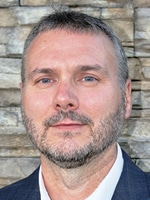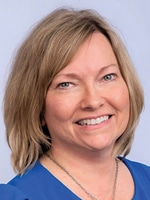February 2022—New year, new variant. For Compass Group lab leaders on a call with CAP TODAY publisher Bob McGonnagle on Jan. 4, omicron was new but the struggles were similar. They spoke of staffing and supplies but also of the CDC’s day-five guidance, crisis planning, instrument downtimes and hard-to-get parts, and doing such things as limiting routine phlebotomy draw times for COVID-positive inpatients. “We’re trying to better utilize dwindling resources on the inpatient phlebotomy side,” said Diana Kremitske, MS, MHA, MT(ASCP), of Geisinger.
The Compass Group is an organization of not-for-profit IDN system laboratory leaders who collaborate to identify and share best practices and strategies. Here is what they told CAP TODAY as the new year began.

Baker
We have now more than 1 million cases in one day in the United States. On New Year’s Eve in Chicago not a single ICU bed was available at the University of Chicago hospitals. Joseph Baker, what’s going on at Baylor Scott & White in Dallas?
Joseph Baker, VP of laboratory, Baylor Scott & White Health, Dallas: This morning, as a system, we’re around a 38 to 40 percent positivity rate. We have a couple of sites doing variant testing that can track S gene dropouts. We’ve seen quite the wave over the past three to four weeks, specifically at Baylor University Medical Center. We went from zero omicron to 30 percent, to 50 percent, and now we’re at 100 percent. Our central Texas area is a little behind our north Texas hospitals, seeing around 60 percent omicron.
Staffing continues to be a struggle and a challenge. We were getting help from our nursing partners with specimen collections when we didn’t have the phlebotomy staff at some of our hospitals, and now they’re equally struggling if not more. We have asked our lab leaders to develop a critical staffing plan.
Supplies—there’s not enough. Testing, pipettes, you name it; we’re struggling to get it.
We know we have a mixture now of several variants. Most of the serious cases would seem to be attributed to delta. Peter Dysert, what is your feeling about what we’re told about omicron so far?
Peter Dysert, MD, chief, Department of Pathology, Baylor Scott & White Health, Dallas: Time will answer that question. The biggest issue for us now is making a therapeutic decision in that window of time, if we can tell somebody they have omicron versus delta. Two of three agents aren’t effective in omicron. In trying to conserve those things, we’ve been asked if we can differentiate omicron from delta.
Is that an ongoing exploration as of today?
Dr. Dysert (Baylor Scott & White): Yes, it is. We have the Thermo Fisher QuantStudio, so we screen using S gene dropout, making the assumption that those S gene dropouts are omicron. When we’ve been able to sequence them, when we have reagents, 100 percent of our S gene dropout patients confirmed genetically is omicron.
Greg, tell us what’s going on in New Orleans.
Greg Sossaman, MD, system chairman and service line leader, pathology and laboratory medicine, Ochsner Health, New Orleans: Our point-of-care positivity is about 45 percent in urgent care and ED settings. We do quite a bit of point of care with ID Now. It’s about 30 percent for PCR positivity.
We continue to see issues with the volumes we’re putting through the instruments; there are significant downtimes. They seemingly aren’t necessarily engineered for the volumes we’re using them for now.
Is your servicing of equipment up to snuff or is that also strained given the volumes?
Dr. Sossaman (Ochsner): It is strained because most of the time the engineers are flying in from somewhere else and with flight delays, travel, and weather, it’s been problematic.
Myra Wilkerson, tell me from your medical point of view what’s happening at Geisinger.
Myra Wilkerson, MD, chair of laboratory medicine, Geisinger, Danville, Pa.: This morning our overall system positivity rate was about 38 percent. For ambulatory, it’s about 51 percent positive. We do NGS, but only a small sampling every month to see if there’s a shift. Until now, it hasn’t been a problem; the treatments were all the same. But with the change in the variants and the effectiveness of certain antibody therapy, we may have to start doing more sequencing.
Elective surgeries were canceled until January 15. We’re still running ORs in some of our hospitals but only for critical surgeries.
Lab staffing is a challenge but nursing is the biggest challenge. With physicians and especially surgeons cutting back on their OR schedules, they’re doing either primary inpatient service instead of being just consults, so in a lot of cases the hospitals are devoted to ICU and COVID patients. The other services are covering as primary admitting services. Some surgeons and some of our pathology group are covering vaccine clinics to free up nurses so they can go to inpatient service.
We saw a lot of data late last year about a serious delay in cancer diagnoses. Is that your experience at Geisinger as you look at the data?
Dr. Wilkerson (Geisinger): We haven’t specifically looked at it, but there is a lot of catch-up. The dermatology clinics were shut for several months so they are catching up. One of the biggest things we’re seeing is skin cancers, especially melanoma.
Diana Kremitske, can you comment on the supply chain issues you may be experiencing at Geisinger?
Diana Kremitske, MS, MHA, MT(ASCP), VP, Diagnostic Medicine Institute, Geisinger, Danville, Pa.: The PST and SST tubes are still an issue. We have several mitigation plans in place, including converting to plain red tops, which requires extra processing time on the front end. We’re doing that on the outpatient side in select locations staffed by laboratory personnel to handle the front-end processing work prior to shipping those specimens to the core laboratory. We’re monitoring that week to week to understand what our supply on hand is. Right now, we’re about a 13- to 14-week supply on hand for the entire system for SST and PST tubes but still working on continuing those mitigation plans.

Kremitske
We are refreshing our communications about the utility of inpatient phlebotomy, especially on COVID-positive patients and persons under investigation for COVID who are inpatients, and limiting those routine draws to two times a day: 4 AM to 8 AM for morning rounds purposes and then in the evening at about 4 PM to 8 PM. Of course, if situations warrant a stat or there’s a worsening clinical situation, the laboratory would respond to that as requested. We’re trying to better utilize dwindling resources on the inpatient phlebotomy side by limiting routine draws to those hours for COVID-positive patients.
How long has that been in effect?
Diana Kremitske (Geisinger): We put that into effect in 2021, and we felt with the recent surge we needed to refresh that communication. At times we start to see an inappropriate use of stats just to get it done. So we reached out to our chief medical officers and nursing officers to help us with that communication and encourage providers to use the time frames for routine blood draw times. It’s difficult for the phlebotomists to manage large worklists on a case-by-case basis, despite being aided by technology. We need our clinician partners to support us in the appropriate utilization.
I’m going to turn to Dwayne Breining for a report from Northwell.

Dr. Breining
Dwayne Breining, MD, executive director, Northwell Health Laboratories, New York: We’re still seeing a vertical rise in new cases in New York. There is not enough testing to go around. Everybody’s turnaround time is extended out. We’re doing about 90 percent of PCRs within 48 hours of receipt in the lab. We did 25,000 tests yesterday and if I had 25,000 more, they would be taken up in an hour or two.
One-third of our tests overall are positive. We had set up genotyping about three weeks ago to differentiate between omicron and delta, thinking it was going to be significant because of the therapeutic choices, and in one week’s time we saw it go from 20 to 80 percent omicron. We’ve been at virtually 100 percent for the past two weeks.
It used to be only about 10 percent of our COVID inpatients were fully vaccinated; now about one-third are. It’s mostly with comorbidities and other such things, but this variant does seem to get through the vaccines easier than the others.
Jim Crawford, do you share the opinion of some that the CDC has muddied the waters with its pronouncements regarding 10 days versus five?
James Crawford, MD, PhD, professor and chair, Department of Pathology and Laboratory Medicine, and senior VP, laboratory services, Northwell Health, New York: The challenge the CDC faces, which is trying to extrapolate from surveillance data into policy and medical recommendations, is enormous. I have been in conversation with the CDC and the National Cancer Institute—which is the sponsor for SeroNet [NCI Serological Sciences Network], which is the national consortium on antibody science and practice in the United States—about how the United States can better leverage its data to inform public policy and the practice of medicine. The challenge is connecting the dots to be able to make sense of massive streams of data in the midst of a population that is churning its way into the new year. I am empathetic to the CDC for the challenge it faces. And my own interpretation is, there is a pressing need to have health care workers be able to return to work in the midst of COVID racing through their communities and taking people off the job.

Dr. Crawford
For the health care industry, and I would use Northwell as the example, to translate public policy as expressed by the CDC into specific recommendations for a health system workforce is something that Dr. Breining and I depend on—particularly with regard to the importance of laboratory testing for our workforce and of what we are calling “friends and family,” not just the team member. The health care workforce is so stressed now 22 months into this pandemic. And then we have essential workers across the whole span of civic responsibility and the rest of our society. So my fundamental response to you is, I am empathetic to the CDC to try to keep people on the job to fulfill the requirements of our society. And, yes, it is difficult and confusing.
Lauren Anthony, can you fill us in on your experience in Minneapolis?
Lauren Anthony, MD, system laboratory medical director, Allina Health, Minneapolis: In our system, we have eight COVID-19 platforms going and none of them have an S gene target. We’re going with the health department’s statement that we’re rapidly converting to omicron. Our formularies decided to not offer the monoclonal antibody therapies that are less effective with that variant, so those aren’t orderable anymore and there is an allocation process for the effective therapy. We have a scarce resource team and the state has a scoring and application mechanism to show equity in dispensing those doses. So we are not doing anything specific for the omicron variant. It wouldn’t be practical, even if we brought in a platform with an S gene target to see if it dropped out. We couldn’t manage all the testing.
At this point, 30 percent of our symptomatic outpatients are COVID positive, but our pre-op is about four to five percent positive. That’s much higher than it had been.

Dr. Anthony
Now that people are doing home testing, there might be a patient who comes in for surgery and says, “I had a home test positive and I’ve isolated for 10 days.” What do you do with them? Because if they did have COVID, testing positive doesn’t mean much. We’re having discussions about managing patients in that context who did their own test, had symptoms, and said they isolated on their own.
 CAP TODAY Pathology/Laboratory Medicine/Laboratory Management
CAP TODAY Pathology/Laboratory Medicine/Laboratory Management
